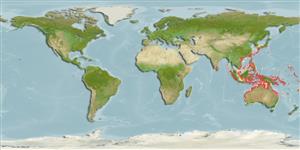Common names from other countries
>
Eupercaria/misc (Various families in series Eupercaria) >
Labridae (Wrasses) > Corinae
Etymology: Hologymnosus: Greek, holos = full + Greek, gymnos = naked (Ref. 45335).
More on authors: Randall & Yamakawa.
Environment: milieu / climate zone / depth range / distribution range
Écologie
marin récifal; profondeur 15 - 40 m (Ref. 90102). Tropical
Western Pacific: Japan to Indonesia.
Taille / Poids / Âge
Maturity: Lm ? range ? - ? cm
Max length : 32.0 cm TL mâle / non sexé; (Ref. 9710)
Épines dorsales (Total): 9; Rayons mous dorsaux (Total): 12; Épines anales 3; Rayons mous anaux: 12
Inhabits seaward reefs, in areas of mixed sand, rubble, and coral (Ref. 9710). Often found in areas with Halimeda algea. May be solitray or form groups. East indian reef fishes of this species are mostly young and rarely larger than 10 cm (Ref. 90102).
Life cycle and mating behavior
Maturité | Reproduction | Frai | Œufs | Fécondité | Larves
Oviparous, distinct pairing during breeding (Ref. 205).
Randall, J.E. and T. Yamakawa, 1988. A new species of the labrid fish of the genus Hologymnosus from the Western Pacific, with notes on H. longipes. Rev. Fr. Aquariol. 15(1):25-30. (Ref. 5277)
Statut dans la liste rouge de l'IUCN (Ref. 130435)
CITES (Ref. 128078)
Not Evaluated
Menace pour l'homme
Harmless
Utilisations par l'homme
Plus d'informations
PaysZones FAOÉcosystèmesOccurrencesIntroductionsStocksÉcologieRégime alimentaireÉléments du régime alimentaireConsommation alimentaireRation
RéférencesAquacultureProfil d'aquacultureSouchesGénétiqueElectrophoresesHéritabilitéPathologiesTraitementMass conversion
CollaborateursImagesStamps, Coins Misc.SonsCiguateraVitesseType de nageSurface branchialeOtolithesCerveauxVision
Outils
Articles particuliers
Télécharger en XML
Sources Internet
Estimates based on models
Preferred temperature (Ref.
115969): 20.6 - 28.8, mean 27.4 (based on 174 cells).
Phylogenetic diversity index (Ref.
82804): PD
50 = 0.5625 [Uniqueness, from 0.5 = low to 2.0 = high].
Bayesian length-weight: a=0.00977 (0.00470 - 0.02030), b=3.07 (2.89 - 3.25), in cm Total Length, based on LWR estimates for this (Sub)family-body shape (Ref.
93245).
Niveau trophique (Ref.
69278): 3.9 ±0.6 se; based on size and trophs of closest relatives
Résilience (Ref.
120179): Milieu, temps minimum de doublement de population : 1,4 à 4,4 années (Preliminary K or Fecundity.).
Fishing Vulnerability (Ref.
59153): Low vulnerability (22 of 100).
